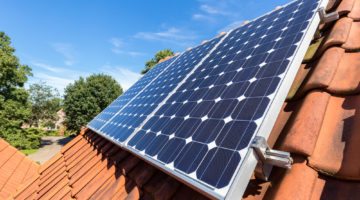
UPDATE: The Feed-In Tariff is now closed for new applications. To find out about the new scheme designed to replace it, click here.
The cost of solar has come down dramatically in the last few years, to the point where solar PV is a viable option for many households. The market for domestic size systems is highly competitive and as a result you can get a good quality 4kW system for under £7,000 these days. Ikea has gone one step further and is now offering a cut price solar PV system for the home at a price of £5,700 inclusive of VAT for a 3.36kW system.
How does it work?
Many Ikea stores now have sales reps for solar PV. The first step is to talk to one of them and they will give you an idea of feasibility. Simple checks like looking at your roof on Google Earth are carried out and the rep will create a simple design on the computer to give you an idea of the sort of system you could have.
The next step is to arrange for a solar PV feasibility survey to be carried out. A surveyor will come to your home, take measurements and let you know exactly what sort of system you will be looking at.
Do you get feed in tariff payments with Ikea?
Yes. The system meets all the relevant regulations, with the installers being MCS accredited and as such you can claim feed in tariff payments with Ikea. Remember, the Feed-in tariff is what makes solar PV so attractive, providing a return of approximately £800 every year (guaranteed for 20 years). The return is made up of the actual Feed-in tariff payments (for generating the electricity and exporting it back to the grid) as well as the reduction in your electricity bill you simply use what you produce.
Remember, key to getting the highest Feed-in tariff payment is to submit your application with an EPC with at least a Band ‘D’ efficiency rating – if you don’t do this, you will be paid the lower feed-in tariff payment, which will dramatically reduce your solar PV return.
 Are there cheaper options?
Are there cheaper options?
There may be some companies offering cheaper panels, but chances are they are using low quality Chinese panels and inverters, which are liable to pack up very quickly. The Ikea panels are made by Hanergy Solar, who are a large Chinese manufacturer and the biggest solar company in the UK. As a larger manufacturer they can produce relatively reliable panels at a reasonable price. That’s not to say that there are not better panels on the market however. You can pay a bit more and get a high quality system, but it depends on what you are looking for.
What sort of return can I expect?
Whilst this is a little below the market rate, the price is not a million miles away from other installers on the market. The feed in tariff is reducing again in April, which means that you should get the system installed before then to maximise your return. Even so, you are looking at a payback time of 8-10 years.
So Ikea’s product could be described as much like their furniture, it is low cost, no frills, but functional. If you are looking for the Rolls Royce of solar this isn’t it, but it might be a good low cost option for your home.












already got them from ikea perfect now earning me money and will have paid for themselves in less than 4 years then pure profit getting about 26% return better than any money in any bank ! beat that !!
Also got these and can’t say enough good things about them. The install service was easy and quick, our energy bills are hardly anything now. They should have paid for themselves in 6 years we think, and that’s not even taking into account rising bills in the future. We will be rolling in it by that time 🙂 One of the best purchases I have ever made! Bring on the CASH!
No-one mentions ACTUAL figures ? I these are £5,700 and pay for themselves within 4-6 years that’s around £1000 per year? In the meantime – people say their ‘bills are so much lower without mentioning figures again … very frustrating …. my gas and electricity combines is around £120-150 per month winter … I have two adults living in a two bedroom end terraced – so – how does this compare to what id be paying combined if I had the solar panels … and how do you get the ‘feed in tarif’ money – is it discounted from your bills or credited to your account and approx. HOW MUCH is it ..why wont anyone I ask about these offer up REAL TANGIABLE FIGURES ???
Hi Innes,
The return is dependant on the amount of sun! But follow these workings – they will be pretty close.
So a 4kW system will produce approximately 3320kWh per year if they are south facing (although slightly less if east or west). For every one of these units, you get paid the Feed in tariff for producing the electricity – this currently is 13.39p / kWh. Therefore you will receive a payment of £444 per year from this.
The next thing to consider is the electricity bill savings – electricity costs about 13.5p / kWh to buy from suppliers – so if you can use all the electricity you produce (remember solar panels only produce electricity during the day and they make a lot more in the summer compared to the winter), you are looking at a bill saving £450. Obviously is it unlikely you are going to use it all, but there are mechanisms that allow you to do this including behavioural changes and taking any excess to your immersion unit on your hot water tank.
Finally, you also get paid an export tariff – however solar PV systems rarely have export meters installed, instead the Government halves the kWh generated and pays you the export tariff on this (basically they assume you export 50%). The export tariff as of 1st May 2015 is 4.85p / kWh, so this pays you £80 based on generating a total of 3320kWh (the workings for this are 3320 x 0.5 x 0.0485).
So taken together this gives you a figure of near enough £1,000 – so that is why people quote those figures!
The Feed-in tariff payment (including both the Generation tariff and the export tariff) are both paid quarterly – so money actually comes to you. The electricity bill savings is obviously a reduction in your bill compared to normal usage.
In terms of your bills, that sounds about average – obviously if you had solar PV your electricity demand in winter would be slightly lower (although you produce a fraction of the electricity in the winter compared to what you produce in the summer), but in terms of heating savings – solar PV isn’t going to do much unless you can plug in some electric heating in the home!
I hope that has made some bits clear – if not, ask away and I will try to explain bits further.
Thanks!
James
Nice one James. Was curious about a few of these points also. Thanks for the explanation 🙂
Should have had these installed sooner! Also had an immersun unit fitted at same time to save even more money role on the sunshine
We are a technology company that specialises in commercialising power products effecting transport and communication systems. We have a new solution for the Solar Panel technology we have been developing and using at the European Space Agency, it is possible IKEA will know our name as we have in the past discussed IKEA Rail B. The new technology is a fluid application that when applied to a solar panel increases performance up to 40%, should this technology interest IKEA, please advice?